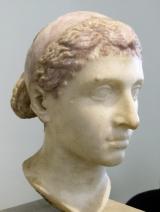Ki randizott Julius Caesar-szel?
Postumia Julius Caesar dátummal kelt, ? és ?. között
Postumia Julius Caesar dátummal kelt, ? és ?. között
Mamurra Julius Caesar dátummal kelt, ? és ?. között
Mucia Tertia Julius Caesar dátummal kelt, ? és ?. között
Lollia Julius Caesar dátummal kelt, ? és ?. között
Servilia Julius Caesar dátummal kelt, ? és ?. között
Cossutia Julius Caesar dátummal kelt, ? és ?. között
Sempronia Julius Caesar dátummal kelt, ? és ?. között
Eunoë Julius Caesar dátummal kelt, ? és ?. között
Clodia Julius Caesar dátummal kelt, ? és ?. között
Tertulla Julius Caesar dátummal kelt, ? és ?. között
Nysa Julius Caesar dátummal kelt, ? és ?. között
VII. Kleopátra Julius Caesar dátummal kelt, és . között A korkülönbség 30 hónapig és 6 napig tartott volt.
Julius Caesar

Caius Iulius Caesar (vagy Gaius Julius Caesar ; i. e. 100. július 12./13. – i. e. 44. március 15.) római hadvezér és politikus. Fontos szerepet játszott a köztársaság felszámolásában és a császárság intézményének létrehozásában. Elfoglalta Galliát, és elsőként vezetett hadjáratot Britanniába – mindkettőt saját kezdeményezésre. Minden idők egyik legnagyobb hadvezére (stratégája) volt és nagyszerű politikus is (mindkettő alatt leginkább az értendő, hogy kitűnően tudott bánni az emberekkel). Jelentősége az ókor történetében Nagy Sándoréval vetekedik.
Kiépülő egyeduralma a királyságot (egyszemélyi uralmat) átoknak tekintő Rómában hamar komoly ellenérzésekkel találkozott. Polgárháború bontakozott ki ellene, amit megnyert, és az így létrejött birodalom vitathatatlan urává lett. Mélyreható reformokba kezdett. Élethossziglani dictatorrá nyilvánította magát és erőteljesen központosította a köztársaság kései éveiben szétzilálódott közigazgatási rendszert. Mondhatni, mindent sikerült megnyernie, csak polgártársait nem: Róma nem tolerálta őt. Az egyre hangosabb zúgolódást és a diktatúrát látva Marcus Brutus és több szenátor összeesküdött és meggyilkolták Caesart, abban a reményben, hogy sikerül megmenteniük a köztársaságot. A merénylet után azonban polgárháború tört ki Caesar hívei (Octavianus, Marcus Antonius, Lepidus) és a köztársaságiak (Brutus, Cassius, Cicero és még sokan mások) között.
Bővebben...Postumia
Julius Caesar

Postumia
Julius Caesar

Mamurra
Mamurra (fl. 1st century BC) was a Roman military officer who served under Julius Caesar.
Bővebben...Julius Caesar

Mucia Tertia
Múcia Tércia (em latim Mucia Tertia) foi uma matrona romana que viveu no século I a.C. Era filha de Quinto Múcio Cévola, pontífice máximo (pontifex maximus),[carece de fontes?] assassinado pela facção de Caio Mário em 86 a.C., e de Licínia Crassa, que se divorciou do seu pai para se casar com Quinto Cecílio Metelo Nepos, num escândalo mencionado em várias fontes. O seu nome indica que era uma terceira filha, de acordo com a convenção romana de nomes.
O primeiro marido de Múcia Tércia foi Caio Mário, o Jovem, cônsul em 82 a.C. no pico da guerra civil contra os Optimates liderados por Lúcio Cornélio Sula. Pouco depois, o conflito acabou com o suicídio do jovem Mário e com a vitória de Sulla. Múcia, como viúva de um proscrito, ficou proibida de voltar a casar. No entanto, em 81 a.C., Sula mudou de ideias e patrocinou o seu casamento com Pompeu. Desta união nasceram três crianças: Pompeu, o Jovem,[carece de fontes?] Sexto Pompeu e Pompéia Magna (que casou-se com Fausto Cornélio Sula).
Entre 76 e 61 a.C., Pompeu passou muito tempo fora de Roma, combatendo os piratas do Mediterrâneo, a rebelião de Sertório na Hispânia e o rei Mitrídates VI do Ponto. Quando regressou definitivamente a casa, enviou uma carta de divórcio a Mucia Tertia; Plutarco menciona uma correspondência pessoal de Cícero que teria o motivo desta separação. Múcia Tércia desaparece então das fontes e a data da sua morte é incerta. Muitas fontes afirmam que Júlio César era amante de Múcia, e, portanto, o pivô dessa separação.
Bővebben...Julius Caesar

Lollia
Lollia was an Ancient Roman noblewoman. She was the wife of Roman general Aulus Gabinius. She was also a mistress of Julius Caesar.
Bővebben...Julius Caesar

Servilia

Серви́лия Ста́ршая (лат. Servilia Maior; около 100 — после 42 гг. до н. э.) — римская матрона, известная в первую очередь как мать Марка Юния Брута. Она принадлежала к нобилитету и была женой двух знатных плебеев из рода Юниев: Марка Юния Брута (народного трибуна 83 года до н. э.) и Децима Юния Силана (консула 61 года до н. э.). Долгое время состояла во внебрачной связи с Гаем Юлием Цезарем, так что некоторые античные авторы именно Цезаря называют настоящим отцом её единственного сына.
Bővebben...Julius Caesar

Cossutia

Cosucia (en latín, Cossutia; fl. Siglo I a. C.) fue una noble romana.
No se sabe nada de su familia, tan sólo que formaba parte de la gens Cosucia, una familia de la nobleza ecuestre de Roma y probablemente originaria de Corinto. Según Suetonio estuvo prometida a Julio César en 84 a. C., mientras éste llevaba la toga pretexta. La repudió un año más tarde para casarse con Cornelia, hija de Lucio Cornelio Cinna, cónsul en 83 a. C.
Bővebben...Julius Caesar

Sempronia

Sempronia war eine römische Aristokratin der späten Republik. Sie war die Frau des Decimus Iunius Brutus, Konsul des Jahres 77 v. Chr., und nach Sallust aktive Teilnehmerin – zumindest Mitwisserin – an der catilinarischen Verschwörung.
Bővebben...Julius Caesar

Eunoë

Eunoë Maura was the wife of Bogudes, King of Western Mauretania. Her name has also been spelled Euries or Euryes or Eunoa.
Bővebben...Julius Caesar

Clodia

Кло́дия Пу́льхра Те́рция (урождённая Кла́вдия Пульхра Терция; сменила имя на «Клодия»; часто упоминается как просто Клодия, иногда — Клодия Мете́лла или Клоди́лла; лат. Clodia Pulchra Tertia; родилась, по одной из версий, в 95 году до н. э. — умерла не ранее 44 года до н. э.) — римская матрона, приходившаяся старшей сестрой мятежному народному трибуну 58 года до н. э. Клодию. Предположительно, могла быть причастной к отравлению собственного супруга и консуляра Квинта Цецилия Метелла Целера.
По распространённому в современной историографии мнению, послужила прообразом Лесбии в произведениях римского поэта Гая Валерия Катулла.
Bővebben...Julius Caesar

Tertulla
Julius Caesar

Nysa
Ниса (др.-греч. Νύσα) — дочь царя Вифинии Никомеда IV (по другим, видимо, устаревшим сведениям — Никомеда III), жившая в I веке до н. э.
Bővebben...Julius Caesar

VII. Kleopátra

Cleopatra VII Thea Philopator (Koine Greek: Κλεοπάτρα Θεά Φιλοπάτωρ, lit. 'Cleopatra father-loving goddess'; 70/69 BC – 10 or 12 August 30 BC) was Queen of the Ptolemaic Kingdom of Egypt from 51 to 30 BC, and the last active Hellenistic pharaoh. A member of the Ptolemaic dynasty, she was a descendant of its founder Ptolemy I Soter, a Macedonian Greek general and companion of Alexander the Great. Her first language was Koine Greek, and she is the only Ptolemaic ruler known to have learned the Egyptian language, among several others. After her death, Egypt became a province of the Roman Empire, marking the end of the Hellenistic period in the Mediterranean, which had begun during the reign of Alexander (336–323 BC).
Born in Alexandria, Cleopatra was the daughter of Ptolemy XII Auletes, who named her his heir before his death in 51 BC. Cleopatra began her reign alongside her brother Ptolemy XIII, but falling-out between them led to a civil war. Roman statesman Pompey fled to Egypt after losing the 48 BC Battle of Pharsalus against his rival Julius Caesar, the Roman dictator, in Caesar's civil war. Pompey had been a political ally of Ptolemy XII, but Ptolemy XIII had him ambushed and killed before Caesar arrived and occupied Alexandria. Caesar then attempted to reconcile the rival Ptolemaic siblings, but Ptolemy XIII's forces besieged Cleopatra and Caesar at the palace. Shortly after the siege was lifted by reinforcements, Ptolemy XIII died in the Battle of the Nile. Caesar declared Cleopatra and her brother Ptolemy XIV joint rulers, and maintained a private affair with Cleopatra which produced a son, Caesarion. Cleopatra traveled to Rome as a client queen in 46 and 44 BC, where she stayed at Caesar's villa. After Caesar's assassination, followed shortly afterwards by the sudden death of Ptolemy XIV (possibly murdered on Cleopatra's order), she named Caesarion co-ruler as Ptolemy XV.
In the Liberators' civil war of 43–42 BC, Cleopatra sided with the Roman Second Triumvirate formed by Caesar's heir Octavian, Mark Antony, and Marcus Aemilius Lepidus. After their meeting at Tarsos in 41 BC, the queen had an affair with Antony which produced three children. Antony became increasingly reliant on Cleopatra for both funding and military aid during his invasions of the Parthian Empire and the Kingdom of Armenia. The Donations of Alexandria declared their children rulers over various territories under Antony's authority. Octavian portrayed this event as an act of treason, forced Antony's allies in the Roman Senate to flee Rome in 32 BC, and declared war on Cleopatra. After defeating Antony and Cleopatra's naval fleet at the 31 BC Battle of Actium, Octavian's forces invaded Egypt in 30 BC and defeated Antony, leading to Antony's suicide. After his death, Cleopatra reportedly killed herself, probably by poisoning, to avoid being publicly displayed by Octavian in Roman triumphal procession.
Cleopatra's legacy survives in ancient and modern works of art. Roman historiography and Latin poetry produced a generally critical view of the queen that pervaded later Medieval and Renaissance literature. In the visual arts, her ancient depictions include Roman busts, paintings, and sculptures, cameo carvings and glass, Ptolemaic and Roman coinage, and reliefs. In Renaissance and Baroque art, she was the subject of many works including operas, paintings, poetry, sculptures, and theatrical dramas. She has become a pop culture icon of Egyptomania since the Victorian era, and in modern times, Cleopatra has appeared in the applied and fine arts, burlesque satire, Hollywood films, and brand images for commercial products.
Bővebben...